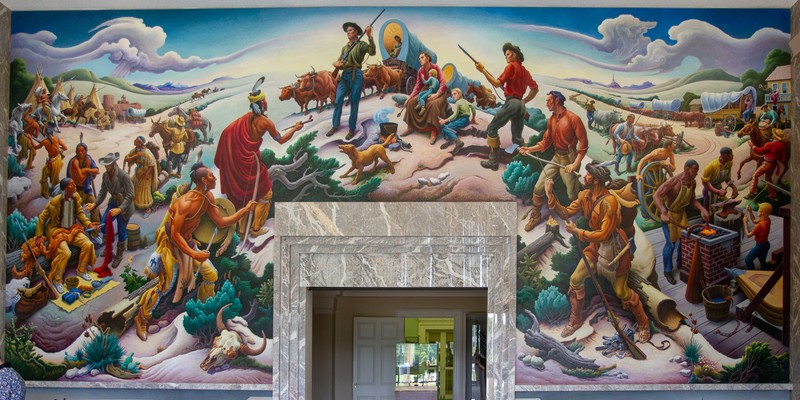"Independence and the Opening of the West"
Introduction
Text-to-speech Audio
One of Thomas Hart Benton’s largest murals is Independence and the Opening of the West at the Harry S. Truman Presidential Library and Museum. Created between 1959 and 1962, this work depicts Independence, Missouri, in the mid-1800s. Benton once again took painstaking care in planning the wall. The idealized picture of the Old West shows the myths many American artists used in their work. Visitors can see the mural in the museum’s original lobby during business hours.
Images
"Independence and the Opening of the West"

Backstory and Context
Text-to-speech Audio
The Harry S. Truman Presidential Library and Museum holds one of Benton’s most notable late works, Independence and the Opening of the West. The huge work was a product of careful historical research and planning. Exchanges and clashes between white settlers, the Black people they enslaved, and Indigenous people in mid-1800s Independence cover the wall. Benton continued his Regionalist focus on local historical mythology.
Truman’s library opened in 1957. Despite Benton’s fall from popular favor, the staff soon asked him to paint a mural for the building. The artist and the former president debated the topic and content of the mural for months. Eventually, they agreed that Benton would depict westward expansion in Independence in the 1840s. The Santa Fe, California, and Oregon trails that pioneers traveled began in the small frontier town. Indigenous people attempt to greet and trade with the white settlers on the left side of the door. Traditional items such as tipis and spears sit next to new goods like rifles and blue jeans. The Rocky Mountains await in the distant background. White settlers come from the right to loom above the doorway, holding rifles and leading oxen-pulled covered wagons. These men seem ready to fight their way through the Indigenous people already living in the area. Two enslaved Blacksmiths work in the lower right corner. This time in the town’s history was one of change and growth.
Benton focused on the concept of Manifest Destiny rather than a specific episode in Independence’s history. For many people, this scene represents the strength of the American spirit. Pioneers suffered for months to find new opportunities. The citizens of frontier towns also survived deprivation and hardships to help those passing through. However, other people see this painting as a symbol of oppression and loss. The white man in the mural’s center physically dominates the Indigenous men below him. Westward expansion meant many of the United States’ original inhabitants lost their land, cultures, and sometimes families. With the US government and military backing the settlers, Indigenous peoples could do little to resist. Perhaps this mural is a fitting tribute to a president that at times caused such polarization.
Benton again created outlines and models to illustrate his ideas. In 1958 and 1959, he traveled west to create reference sketches, where his studies detailed real Pawnee and Cheyenne people and landscapes to insert into his art. The artist worked with a Pawnee man named Brummitt Echohawk. The man gathered people, props, animals, and costumes that would have been accurate in the 1840s. Benton wanted to get every detail right. He also created a model including every figure in the painting. He made sure that no viewpoint would distort the image. Benton finished the mural on time despite severe pain from bursitis on time, working from November 16, 1959, to April 15, 1961. He cared for his work extended from the first idea to the last brushstroke.
Though Truman and Benton were unsure of each other at first, the men soon became friends. The former president laid down the first paint, adding blue to the sky. He was at the library daily and brought visitors to watch Benton work. At the public unveiling, Truman called Benton “the best muralist in the country.”[1] The artist could be a difficult man to befriend, and he knew it. He appreciated Truman’s easy company. The two remained in touch until Truman died in 1972.
Benton’s Regionalist beliefs made him a good fit for creating Truman’s mural. The artist knew how to portray the triumphant historical scene. The project ended with Truman and Benton being good friends. The mural can generate mixed emotions, making it a thought-provoking addition to Truman’s museum. The president dealt with innumerable conflicts during his term, most notably the decision to drop the atomic bombs. This mural gives viewers an opportunity to reflect on the decisions past American leaders made. Whether or not someone agrees with a particular conclusion, looking at a problem from both sides allows people to understand their beliefs more deeply.
Sources
- Wolff, Thomas Hart Benton: A Life, 302.
Adams, Henry. Thomas Hart Benton: An American Original. New York. Alfred A. Knopf, 1989.
Benton, Thomas Hart. An Artist in America. Edition 4. Columbia, MO. University of Missouri Press, 1983.
Wolff, Justin. Thomas Hart Benton: A Life. New York. Farrar, Straus and Giroux, 2012.
https://www.flickr.com/photos/arthurtlabar/48181279136/
